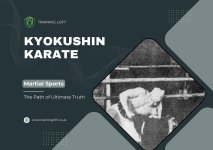Kyokushin Karate, founded by Masutatsu Oyama in 1964, is a full-contact martial art that emphasizes rigorous training, physical endurance, and a philosophy of perseverance and self-improvement. Renowned for its powerful strikes, comprehensive techniques, and intense spirit, Kyokushin is often referred to as the "ultimate truth" in karate, reflecting its pursuit of genuine skill and strength through relentless practice.
Oyama's early training methods were extreme, involving solitary retreats in the mountains where he would train for hours daily, conditioning his body by striking trees and stones. His demonstrations of breaking bricks, stones, and even fighting bulls became legendary, cementing his reputation and that of Kyokushin Karate as a formidable martial art.
Kyokushin's tournaments, such as the All Japan Open and the World Open Karate Championships, draw competitors from around the world, showcasing the style's effectiveness and the dedication of its practitioners.
In karate, belts signify a practitioner’s progress and rank, marking their journey and achievements within the martial art. The journey typically begins with a white belt, representing purity and a beginner’s mind. As practitioners advance, they earn different coloured belts that indicate their growing proficiency and dedication. The V. Sport Karate Belt is an ideal choice for Kyokushin practitioners, available in 240cm or 280cm lengths. These belts feature eight rows of stitching and are made of 100% cotton.
History and Founder
Masutatsu Oyama, a martial artist of Korean-Japanese descent, created Kyokushin after extensive training in various martial arts, including Shotokan Karate, Goju-Ryu Karate, and boxing. Oyama sought to develop a style that combined the best elements of these disciplines, emphasizing realistic combat situations and conditioning the body and mind to withstand the rigors of full-contact fighting.Oyama's early training methods were extreme, involving solitary retreats in the mountains where he would train for hours daily, conditioning his body by striking trees and stones. His demonstrations of breaking bricks, stones, and even fighting bulls became legendary, cementing his reputation and that of Kyokushin Karate as a formidable martial art.
Training and Techniques
Kyokushin Karate training is known for its intensity. Practitioners, or karateka, engage in rigorous physical conditioning, including kihon (basic techniques), kata (forms), and kumite (sparring). The emphasis on full-contact sparring distinguishes Kyokushin from many other karate styles, promoting real-world application and mental toughness.- Kihon (Basics): The foundation of Kyokushin lies in mastering basic techniques. These include punches, kicks, blocks, and stances, practiced repetitively to build muscle memory and precision.
- Kata (Forms): Kata are pre-arranged sequences of movements that simulate fighting multiple opponents. They help practitioners develop balance, coordination, and a deep understanding of the underlying principles of each technique.
- Kumite (Sparring): Kyokushin sparring is full-contact, with minimal protective gear. This approach builds resilience and practical combat skills. Competitions often feature knockdown rules, where bouts are won by knockout, knockdown, or points awarded for effective strikes.
Philosophy and Principles
Kyokushin Karate is more than just a physical discipline; it is a way of life. The philosophy of Kyokushin is encapsulated in the dojo kun (training hall rules) and the karateka's spirit of "osu," a term that conveys respect, perseverance, and patience.- Osu no Seishin: The spirit of perseverance and resilience is central to Kyokushin. Karateka are encouraged to push their limits and endure hardships, both in training and life.
- Dojo Kun: The training hall rules guide practitioners in their conduct, emphasizing values like respect, humility, and self-discipline. These principles extend beyond the dojo, influencing how karateka interact with the world.
- Self-Improvement: Kyokushin promotes continuous self-improvement. Practitioners strive to better themselves physically, mentally, and spiritually, using the challenges of training as a path to personal growth.
Global Influence and Legacy
Since its inception, Kyokushin Karate has grown into a global phenomenon, with dojos in over 120 countries. Its influence extends beyond martial arts, contributing to mixed martial arts (MMA) and other combat sports. Many renowned fighters, including UFC champions, have trained in Kyokushin, incorporating its powerful striking techniques and rigorous conditioning into their arsenals.Kyokushin's tournaments, such as the All Japan Open and the World Open Karate Championships, draw competitors from around the world, showcasing the style's effectiveness and the dedication of its practitioners.
Getting Started with Your First Kyokushin Karate Uniform
If you're about to start your journey in Kyokushin Karate, having the right gear is essential. The IKKEN Kyokushin Karate Gi is an excellent choice for beginners, specifically designed for full-contact karate and featuring the Kyokushinkai kanji on the front left of the jacket. This uniform meets the demands of rigorous training by providing a comfortable fit that allows for unrestricted movement, along with traditional 3/4 length sleeves.In karate, belts signify a practitioner’s progress and rank, marking their journey and achievements within the martial art. The journey typically begins with a white belt, representing purity and a beginner’s mind. As practitioners advance, they earn different coloured belts that indicate their growing proficiency and dedication. The V. Sport Karate Belt is an ideal choice for Kyokushin practitioners, available in 240cm or 280cm lengths. These belts feature eight rows of stitching and are made of 100% cotton.
Conclusion
Kyokushin Karate stands as a testament to the enduring human spirit and the quest for self-mastery. Through its demanding training regimen, full-contact sparring, and philosophical underpinnings, Kyokushin offers more than just a method of combat—it provides a pathway to understanding one's true potential and the ultimate truth within. Whether for self-defence, physical fitness, or personal development, Kyokushin Karate continues to inspire and challenge individuals worldwide to seek the best within themselves.Attachments
Last edited:


